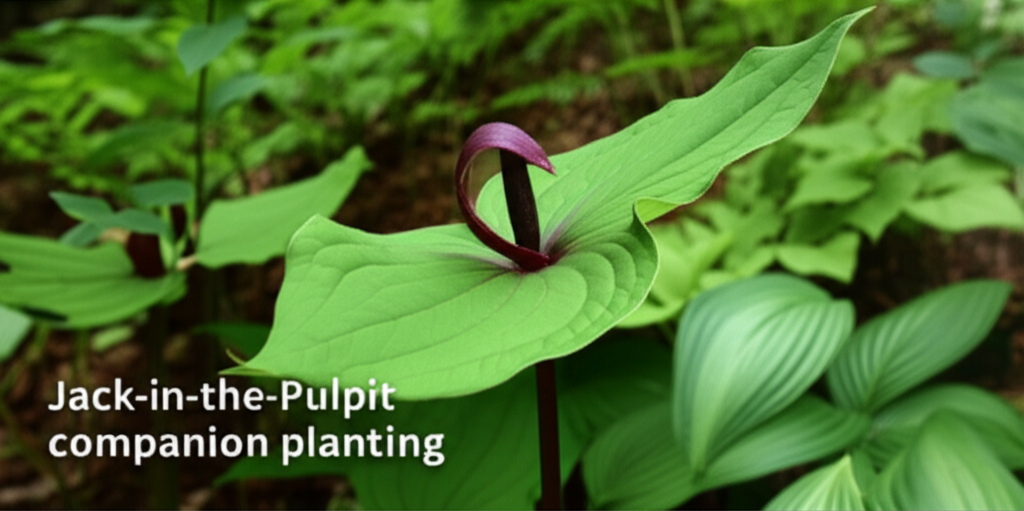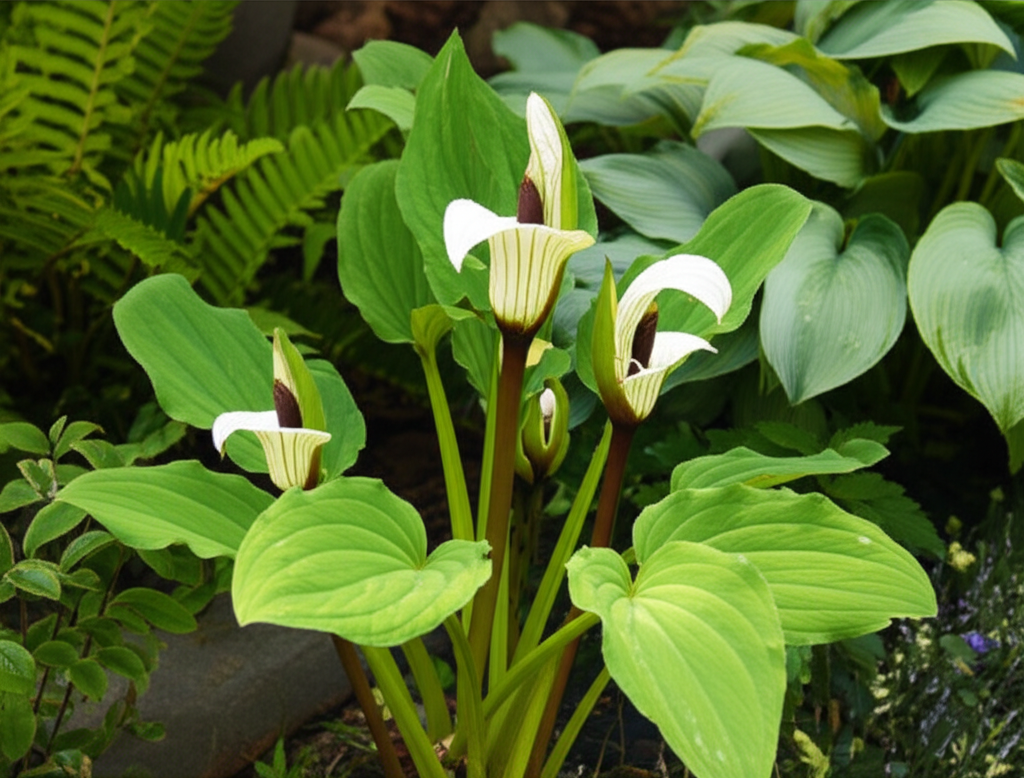Unveiling the Charms of Jack-in-the-Pulpit
Jack-in-the-Pulpit, scientifically known as Arisaema triphyllum, is a captivating woodland native renowned for its unique, spathe-and-spadix flower structure. This distinctive bloom, often resembling a preacher in a pulpit, emerges in the dappled shade of deciduous forests and moist woodlands. Its foliage is equally attractive, with three leaflets forming an umbrella-like canopy. Beyond its visual appeal, Jack-in-the-Pulpit plays a vital role in its native ecosystem, attracting pollinators and providing sustenance for wildlife.
However, cultivating this striking perennial can sometimes present challenges. Its specific needs for consistent moisture, rich organic soil, and protection from harsh sun mean that careful consideration of its companions is crucial for success. Companion planting, the practice of growing compatible plants together, can significantly enhance the health, vigor, and overall appeal of your Jack-in-the-Pulpit and its surrounding garden space. This article delves into the art and science of companion planting for Jack-in-the-Pulpit, focusing on shade-loving perennials that complement its aesthetic and ecological requirements.
Why Companion Planting Matters for Jack-in-the-Pulpit

The principles of companion planting extend beyond simple aesthetics. When strategically chosen, companion plants can offer a multitude of benefits to Jack-in-the-Pulpit and the broader garden ecosystem. These benefits include:
- Improved Soil Health: Certain companion plants can fix nitrogen in the soil, enrich it with organic matter, or help retain moisture, all of which are beneficial for Jack-in-the-Pulpit’s preferred habitat.
- Pest and Disease Management: Some plants are known to deter pests that might bother Jack-in-the-Pulpit or attract beneficial insects that prey on garden nuisances.
- Weed Suppression: Groundcover companions can help suppress weed growth, reducing competition for water and nutrients.
- Moisture Regulation: Plants with similar water needs can create a microclimate that helps maintain consistent soil moisture, crucial for Jack-in-the-Pulpit.
- Enhanced Biodiversity: A diverse planting scheme supports a wider range of pollinators and beneficial insects, contributing to a healthier garden ecosystem.
- Extended Visual Interest: Pairing Jack-in-the-Pulpit with plants that bloom or have attractive foliage at different times of the season ensures continuous visual appeal in the shade garden.
Key Considerations for Selecting Companions
When choosing companions for your Jack-in-the-Pulpit, several factors should guide your decisions:
Light Requirements
Jack-in-the-Pulpit thrives in partial to full shade. Therefore, its companions must also be adapted to similar light conditions. Avoid plants that require full sun, as they will struggle and potentially harm the Jack-in-the-Pulpit.
Moisture Needs
This woodland native prefers consistently moist, well-drained soil. Select companion plants that share this preference for consistent hydration. Dry-loving plants will not be suitable.
Soil Preferences
Jack-in-the-Pulpit benefits from rich, humusy soil with a slightly acidic to neutral pH. Companions that also appreciate these conditions will foster a harmonious environment.
Growth Habit and Size
Consider the mature size and growth habit of potential companions. You want plants that will complement, not overwhelm, the Jack-in-the-Pulpit. Taller plants should be placed behind or to the side to avoid shading the Arisaema too heavily. Groundcovers can help retain moisture and suppress weeds.
Aesthetic Appeal
Beyond functional benefits, the visual harmony between plants is important. Think about complementary leaf shapes, textures, and bloom colors that will create an attractive and cohesive shade garden.
Top Shade Perennials for Jack-in-the-Pulpit Companion Planting
Here are some excellent shade-loving perennials that make ideal companions for Jack-in-the-Pulpit, categorized by their primary contribution:
For Foliage Texture and Color
The architectural form of Jack-in-the-Pulpit is beautifully enhanced by companions offering diverse foliage.
Hostas
Hostas are the quintessential shade garden plant, offering an incredible variety of leaf colors, sizes, and textures. Their broad leaves can help retain moisture and suppress weeds.
- Why they work: Hostas thrive in similar shady, moist conditions. Their diverse foliage offers a stunning contrast to the Jack-in-the-Pulpit’s unique bloom and tripartite leaves.
- Considerations: Choose hosta varieties that are not overly aggressive in their growth. Smaller to medium-sized varieties are often best to avoid overwhelming the Jack-in-the-Pulpit.
Ferns
Native ferns are natural companions for Jack-in-the-Pulpit, as they inhabit the same woodland environments. They add a delicate, feathery texture that contrasts beautifully with the bolder structure of the Arisaema.
- Why they work: Ferns love shade and consistent moisture, making them perfectly compatible. Species like Ostrich Fern (Matteuccia struthiopteris) and Maidenhair Fern (Adiantum pedatum) are excellent choices.
- Considerations: Ensure adequate spacing, as some ferns can spread.
Heucheras (Coral Bells)
Heucheras offer a spectacular range of foliage colors, from deep burgundy and amber to lime green and silver. Their smaller, mounding habit makes them excellent for edging or interplanting.
- Why they work: Heucheras prefer partial shade and moist, well-drained soil. Their colorful foliage provides a vibrant counterpoint to the green hues of the Jack-in-the-Pulpit and its surroundings.
- Considerations: Some varieties may prefer a bit more dappled sun than deep shade.
For Spring and Summer Blooms
While Jack-in-the-Pulpit’s bloom is primarily in spring, companions can extend the floral display.
Astilbes
Astilbes are renowned for their feathery plumes of flowers in shades of pink, red, and white, which appear in early to mid-summer.
- Why they work: Astilbes require consistent moisture and thrive in partial shade, making them ideal companions. Their airy blooms add a touch of elegance and extend the flowering season.
- Considerations: Ensure adequate moisture, especially during dry spells.
Brunnera (Siberian Bugloss)
Brunnera offers delicate blue, forget-me-not-like flowers in spring, often followed by attractive silver-variegated foliage that adds brightness to the shade garden throughout the season.
- Why they work: Prefers shade and consistently moist soil. The silver variegation of many Brunnera cultivars can brighten up darker corners of the garden.
- Considerations: Ensure good air circulation to prevent fungal issues.
Tiarella (Foamflower)
Tiarella is another native woodland perennial that produces airy, foamy spikes of white or pinkish flowers in spring. Many varieties also feature attractive, often spotted or lobed, foliage.
- Why they work: Thrives in shade and moist, humus-rich soil, perfectly aligning with Jack-in-the-Pulpit’s needs. The delicate flowers and interesting foliage add fine texture.
- Considerations: Can spread gently, filling in spaces nicely.
For Groundcover and Weed Suppression
Low-growing companions can help maintain soil moisture and prevent weed encroachment.
Epimedium (Barrenwort)
Epimedium offers delicate, spurred flowers in spring and attractive, often leathery, evergreen or semi-evergreen foliage that persists through winter.
- Why they work: Highly adaptable to shade and tolerant of drier conditions once established, though they appreciate consistent moisture initially. Their dense growth habit suppresses weeds.
- Considerations: Can be slow to establish but are very long-lived.
Vinca minor (Periwinkle)
Vinca minor is a vigorous evergreen groundcover with glossy leaves and small blue or white flowers in spring.
- Why they work: Tolerant of shade and can help retain soil moisture. Its dense mat suppresses weeds effectively.
- Considerations: Can be quite aggressive, so monitor its spread to prevent it from overwhelming other plants.
Key Facts/Comparison of Companion Plants
Here’s a table summarizing some of the top companion planting choices for Jack-in-the-Pulpit:
| Companion Plant | Primary Benefit | Light Preference | Moisture Preference | Mature Height | Bloom Time | Foliage Interest |
|---|---|---|---|---|---|---|
| Hosta | Foliage variety, weed suppression | Partial to Full Shade | Moist | 6″ – 36″ | Summer | Yes (highly varied) |
| Ferns (e.g., Ostrich Fern) | Texture, native habitat | Partial to Full Shade | Moist to Wet | 18″ – 48″ | N/A (foliage) | Yes (feathery) |
| Heuchera (Coral Bells) | Foliage color, texture | Partial Shade | Moist, well-drained | 8″ – 24″ | Late Spring – Summer | Yes (colorful) |
| Astilbe | Summer blooms, texture | Partial Shade | Moist | 12″ – 36″ | Early – Mid Summer | No (foliage dies back) |
| Brunnera | Spring blooms, variegated foliage | Partial to Full Shade | Moist | 12″ – 18″ | Spring | Yes (silver variegation) |
| Tiarella (Foamflower) | Spring blooms, foliage interest | Partial to Full Shade | Moist, humus-rich | 6″ – 18″ | Spring | Yes (often spotted) |
| Epimedium | Groundcover, weed suppression, evergreen foliage | Partial to Full Shade | Moist (established: tolerant) | 8″ – 12″ | Spring | Yes (evergreen/semi-evergreen) |
| Vinca minor | Groundcover, weed suppression | Partial to Full Shade | Moist (tolerant) | 4″ – 6″ | Spring | Yes (evergreen) |
Steps for Successful Companion Planting
Implementing a successful companion planting strategy involves careful planning and execution.
- Site Assessment: Observe your garden’s light patterns throughout the day and season. Identify areas with consistent partial to full shade and note existing soil conditions.
- Plant Selection: Choose companion plants that align with Jack-in-the-Pulpit’s light, moisture, and soil needs, as well as your aesthetic preferences. Consider the mature size of each plant to ensure adequate spacing.
- Planting Arrangement:
- Place taller companions, like some ferns or hostas, behind or to the side of the Jack-in-the-Pulpit to avoid blocking its light or overwriting its presence.
- Interplant smaller companions, such as Heucheras or Tiarella, around the base of the Jack-in-the-Pulpit to create a layered effect and help retain moisture.
- Utilize groundcovers like Epimedium or Vinca minor at the edges of the planting or between larger specimens to suppress weeds and maintain soil moisture.
- Soil Preparation: Before planting, amend the soil with plenty of organic matter, such as compost or well-rotted leaf mold, to improve drainage and fertility.
- Planting: Plant your Jack-in-the-Pulpit and its companions at the appropriate depths. Ensure good contact between the roots and the soil. Water thoroughly after planting.
- Mulching: Apply a layer of organic mulch (e.g., shredded bark, leaf mold) around the plants. This helps retain soil moisture, suppress weeds, and regulate soil temperature. Keep mulch a few inches away from the crowns of the plants to prevent rot.
- Watering: Water consistently, especially during dry periods, to ensure the soil remains evenly moist.
- Ongoing Care: Monitor your plants for any signs of stress, pests, or diseases. Remove any competing weeds promptly. As plants mature, you may need to divide or relocate them to maintain optimal spacing and health.
Pros and Cons of Companion Planting with Jack-in-the-Pulpit
Companion planting offers numerous advantages but also has some considerations.
| Pros | Cons |
|---|---|
| Enhances aesthetic appeal through diverse textures and colors. | Potential for over-competition for resources if plants are not chosen or spaced carefully. |
| Improves soil health and moisture retention. | Some vigorous groundcovers can become invasive if not managed. |
| Can deter pests and attract beneficial insects. | Requires careful planning and consideration of each plant’s specific needs. |
| Suppresses weed growth, reducing maintenance. | Initial setup may require more effort in sourcing and placing multiple plants. |
| Creates a more resilient and diverse garden ecosystem. | Certain companions might have slightly different nutrient requirements that need to be managed. |
Conclusion: Cultivating a Thriving Shade Garden
Companion planting is an invaluable tool for creating a thriving and visually stunning shade garden centered around the enigmatic Jack-in-the-Pulpit. By carefully selecting partners that share its habitat preferences and complement its unique attributes, you can foster a healthier ecosystem, extend the season of interest, and enjoy a more robust and resilient planting. Embrace the diversity of shade-loving perennials, experiment with different combinations, and watch as your woodland garden flourishes, a testament to the power of thoughtful plant pairings. The Jack-in-the-Pulpit, with its captivating form and ecological significance, truly deserves companions that allow it to shine its brightest in the dappled light of your garden sanctuary.


